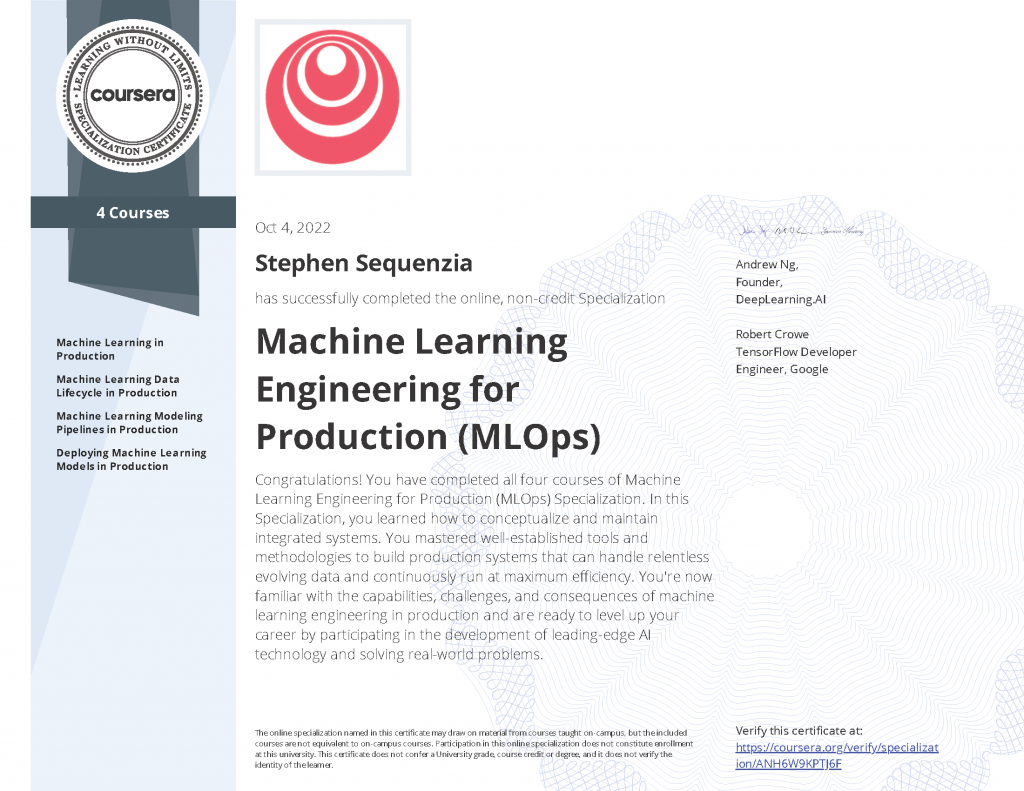StephenSequenzia
Machine Learning Engineer
Stephen Sequenzia
Staff-Plus Machine Learning Engineer & Technical Leader with a strong foundation in Software Engineering, Data Engineering, and MLOps.
With extensive experience creating end-to-end machine learning and data pipelines, I design scalable data architectures, deploy robust ML models, and automate workflows through MLOps best practices. Driven by a passion for transformative AI solutions, I draw on my expertise in software and data engineering, cloud services, and DevOps to bridge the gap between research and production. My goal is to deliver resilient, high-performance ML systems that both push the boundaries of innovation and generate measurable business impact.

What I Do
Machine Learning
MLOps
Data Engineering
Software Engineering
EXPERINCE
Oct 2022 - Present
Lockheed Martin CorporationStaff Machine Learning Engineer | Technical Lead
As both a technical lead and individual contributor specializing in machine learning and data-centric systems, I have driven technical initiatives and led a small but diverse team of software, machine learning, and data engineers to deliver innovative solutions that align with best practices and business objectives. My focus has been on fostering collaboration, promoting technical excellence, and enhancing team capabilities to achieve impactful results in AI and data projects.
- Developed a robust MLOps framework with tools like Ray, Optuna, Weights & Biases, and MLflow, optimizing the entire ML lifecycle from model training to deployment. This framework significantly accelerated deployment, improved model reproducibility, and strengthened data lineage while reducing the complexity and time required for deploying to production.
- Leveraged tools such as Torch Profiler and Nvidia Nsight to diagnose and address inefficiencies in PyTorch-based deep learning anomaly detection models. By refactoring the data loader and rearchitecting key layers, achieved a reduction in training times of over 94%.
- Built highly distributed, functional programming-based data pipelines with Apache Airflow and Dask to support complex machine learning and analytics workflows, enabling efficient, scalable data processing and seamless integration of diverse data sources for enhanced throughput and reliability
- Principal architect of an Apache Arrow-native Data Lakehouse using S3 and PostgreSQL for efficient management of time series data, metadata, and a machine learning feature store, enabling seamless access, high-performance queries, and scalable analytics.
- Refactored a PostgreSQL database for improved normalization, performance, and scalability, reducing query response times by over 95%. Optimizations streamlined data access, minimized redundancy, and enabled efficient scaling to meet higher workloads.
- Deployed and managed a secure, scalable Kubernetes cluster on AWS GovCloud to support ML and data visualization platforms, ensuring high availability, automated scaling, and efficient resource management in a compliant environment.
Feb 2016 - Oct 2022
Applied Theta IncMachine Learning Engineer | Software Engineer | Data Engineer | Owner
Develop analytic opportunities through a suite of frameworks and models designed to expedite development and uphold the integrity of applied AI/ML models tailored to the specific demands of financial markets. Originally built for internal purposes, many of these models and frameworks are now available as open-source resources.
- Developed the entire technology strategy, roadmap, and solutions using agile software development.
- Developed several python-based frameworks and libraries.
- Utilized Machine Learning algorithms to produce financial models and algorithmic trading systems.
- Built advanced data pipelines to handle data from various market sources and time resolutions.
- Standardized codebases to utilize leading data science frameworks like TensorFlow, PyTorch, Keras, NumPy, and Pandas.
- Provided Machine Learning based consulting, design and development to other companies.
Mar 2010 - Aug 2020
Zia Technology Group IncData Engineer | Software Engineer | IT Consultant | Owner
Worked with senior leadership to shape technology strategies for data management, acting as consultant, architect, and lead developer on solution design and development using diverse technologies and agile methods.
- Designed and developed complex data integrations across multiple business applications.
- Deployed many SQL/No SQL databases and designed custom data schemas.
- Designed and deployed data pipeline architectures across multiple data sources and developed ETL processes.
- Full-stack development of several custom web-based applications and reporting systems.
- Designed and implemented highly available virtual infrastructures, fully cloud-based and hybrid co-lo/cloud.
Jan 2007 - Mar 2010
Thinksys IncorporatedSoftware Developer | DBA | IT Consultant | Owner
Collaborated with senior leadership to align technology solutions with business needs, serving as consultant, DBA, and lead developer on critical IT infrastructure projects.
- Set up, deployed, and managed many MS SQL Servers and databases for both custom and 3rd party applications.
- Designed and developed complex data integrations across multiple business applications.
- Developed and deployed web-based interfaces for access to back-end data sources.
- Managed a small team of network engineers and developers.
Dec 2001 - Jan 2007
Biziteks IncorporatedNetwork Engineer | Software Developer | DBA | Owner
Provided full-stack IT consulting, support, and development for small to medium-sized companies in various industries.
- Managed a team of 15 technicians and network engineers.
- Set up, deployed, and managed many MS SQL Servers and databases for both custom and 3rd party applications.
- Set up, managed, and supported hundreds of client networks and applications.
- Developed web-based applications and dynamic websites.
PROJECTS
Photon Machine Learning Framework
A Machine Learning framework that extends the functionality of other frameworks such as TensorFlow and Keras. Photon ML is built to apply neural network and ensemble modeling techniques for deep learning financial algorithms. The framework supports the entire lifecycle of a Machine Learning project including data preparation, model development, training, monitoring, evaluation and deployment.
Project Repo: github.com/sequenzia/photon
Technologies & Methods: Python, Neural Networks, Deep Learning, Distributed Training
Frameworks & Libraries: TensorFlow, Keras, PyTorch, NumPy, Pandas, Apache Arrow, Apache Parquet, Scikit-learn
Key Features of Photon ML:
- Custom object-oriented API with built-in subclassing of Keras and TensorFlow APIs.
- Built-in custom modules such as models, layers, optimizers and loss functions.
- Highly customizable interface to extend built-in modules for specific algorithms/networks.
- Detailed logging and analysis of model parameters to increase interpretability and optimization.
- Works natively with TensorFlow distributed strategies.
- Real-time data preprocessing; dataset splitting, normalization, scaling, aggregation and time series resampling.
- Custom batching, padding and masking of data.
- Designed to be model/algorithm agnostic and to work natively with container services.
- Natively shares input and output between multiple networks to streamline deep ensemble learning.
- Simple interface for saving, serializing and loading entire networks including learned and hyper parameters.
- Custom dynamic learning rate scheduling.
Modeling Research & Development
An evolving collection of data models and algorithms used to model financial markets including equities, options, futures and crypto assets. The project has grown from only traditional statistical modeling to Machine Learning based modeling which includes deep neural networks and probabilistic reasoning networks.
Project Repo: github.com/sequenzia/dyson
Technologies & Methods: Deep Learning, Neural Networks, Regression, Classification, Probabilistic Reasoning, Deep Ensemble Learning, Back-Propagation, Statistical Analysis, Financial Modeling
Frameworks & Libraries: TensorFlow, Keras, Pandas, NumPy, Seaborn, Matplotlib, Statsmodels, Scikit-Learn
Algorithms & Models: CNNs, RNNs, Transformers, Attention Mechanisms, Temporal Conv Networks, Autoencoders, Bayesian Neural Networks, ARIMA, Structural Time Series
- Performed predictions and quantitative analysis of asset prices with a focus on making predictive inferences on time series data.
- Utilized advanced generalization and regularization techniques to increase the performance of models outside training data sets.
- Developed custom optimizers and loss functions to address the unique complexities of time series market data.
- Conducted extensive exploratory data analysis (EDA), feature engineering, data scaling/normalization, resampling, and principal component analysis (PCA).
Machine Learning Preprocessing & Pipelines
Developed a set of custom libraries to handle the unique characteristics of acquisition, preparation and storage of financial market data. These libraries include WebSockets/RESTful API data connectors to access data, detect anomalies in hundreds of millions of data points, then cleanse and pre-process to provide high-integrity data modeling. Also included is a set of tools for domain specific feature engineering and labeling of financial market data.
Project Repo: github.com/sequenzia/maxwell
Technologies & Methods: Data Preprocessing and Cleaning, Feature Engineering, Machine Learning Pipelines, Data Labeling, WebSockets/RESTful APIs, Nvidia CUDA GPUs, Python Data Structures and Storage
Frameworks: Pandas, NumPy, Numba, Rapids AI, DASK, Apache Arrow, Apache Parquet, Scikit-learn, Seaborn, Matplotlib
- Utilized domain knowledge to engineer features based on technical indicators and statistical markers.
- Processed over 20 years of both trading and book market data with multiple time resolutions.
- Increased the speed and efficiency of data storage and retrieval, utilizing Apache Arrow for in-memory columnar storage and Apache Parquet for persistent on-disk storage.
- Produced a wealth of useful tools for managing the flow of data for various modeling and algorithmic trading, orchestrating Machine Learning pipelines, providing a high level of fluidity to feature extraction and helping to increase the integrity of the data.
- Designed custom procedures to label time series data with algorithmic trading attributes such as stop losses, long/short price targets, ATR and VWAP values.
- Processed and stored data from high-volume real-time market data APIs.
- Automated data labeling, binning, one-hot encoding, scaling and normalization of time series market data.
Algorithmic Trading System
Developed set of tools and libraries designed to interface with market brokers and execute algorithmic trading. The algorithmic trading systems executes both buy and sell orders in equities, options, futures, and crypto markets. The tools also support back testing of trading algorithms, applying predictive models to historical data to evaluate their accuracy.
Technologies & Methods: Python, C++, Algorithmic Trading, Financial Models
Frameworks: NumPy, SciPy, Pandas, Numba, Seaborn, Matplotlib, Statsmodels
- Developed utilizing object-oriented programming in Python and C++ for increased performance.
- Designed a set of libraries that work with both rules-based and Machine Learning based models and algorithms.
- These same libraries can be used for both live execution of algorithmic trading systems and back testing.
- Produced a highly functional and efficient algorithmic trading and back testing system; able to trade various assets in various markets and provide increased exposure to key trading metrics.

